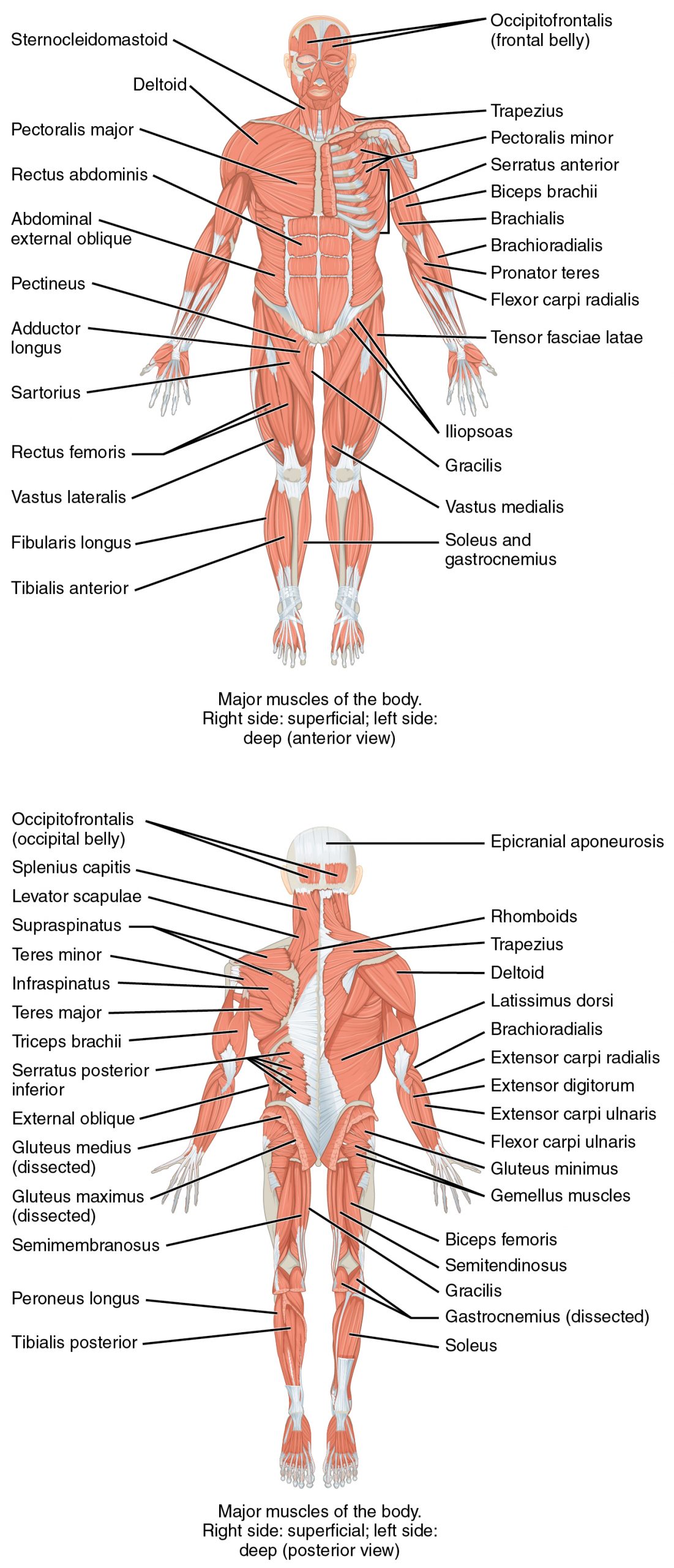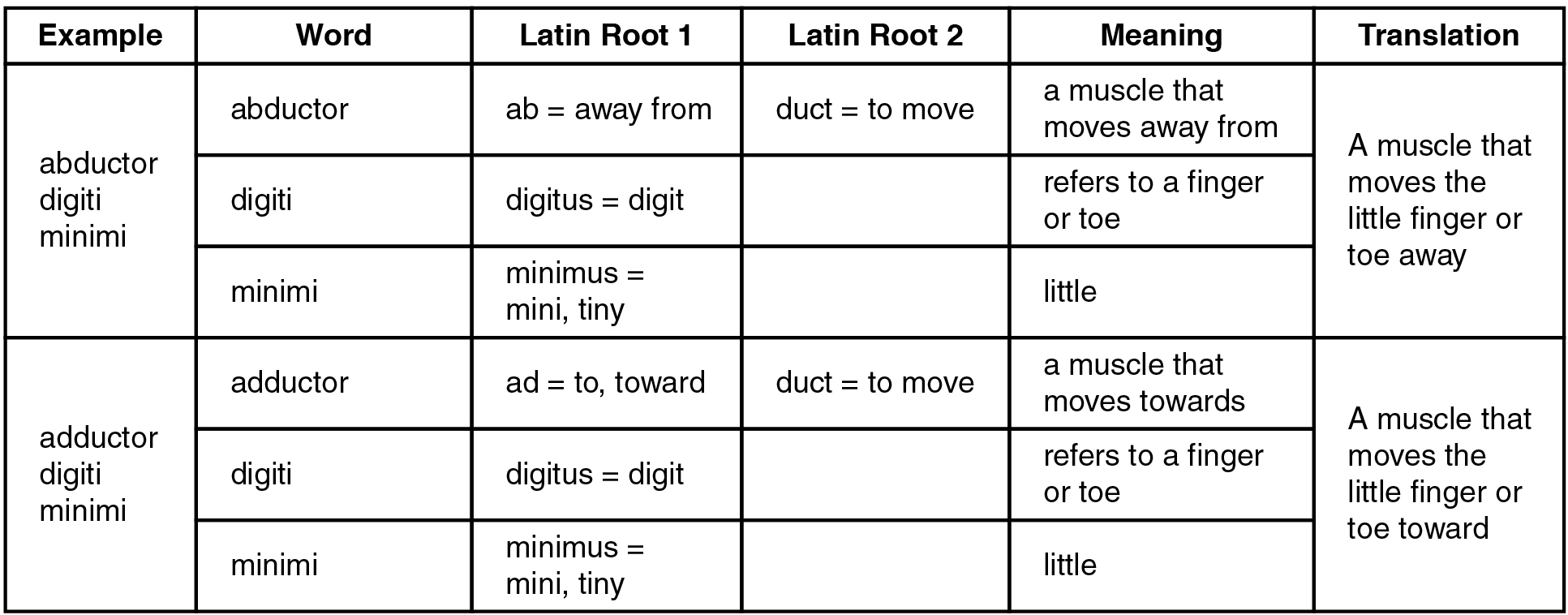11.3 Explain the criteria used to name skeletal muscles
Learning Objectives
By the end of this section, you will be able to identify the following:
Describe the criteria used to name skeletal muscles
Explain how understanding the muscle names helps describe shapes, location, and actions of various muscles
Taking the time to learn the Latin and Greek roots of the words is crucial to understanding the vocabulary of anatomy and physiology. When you understand the names of muscles it will help you remember where the muscles are located and what they do (Figure 11.3.1, Figure 11.3.2, and Table 11.2).


Understanding a Muscle Name from the Latin
| Example | Word | Latin Root 1 | Latin Root 2 | Meaning | Translation |
|---|---|---|---|---|---|
| abductor digiti minimi | abductor | ab = away from | duct = to move | a muscle that moves away from | A muscle that moves the little finger or toe away |
| digiti | digitus = digit | refers to a finger or toe | |||
| minimus = mini, tiny | little | ||||
| adductor digiti minimi | adductor | ad = to, toward | duct = to move | a muscle that moves towards | A muscle that moves the little finger or toe forward |
| digiti | digitus = digit | refers to a finger or toe | |||
| minimi | minimus = mini, tiny | little |
Here are two examples of how root words describe the location and function of muscles.
| Mnemonic Device for Latin Roots (Table 11.2) | ||
|---|---|---|
| Example | Latin or Greek Translation | Mnemonic Device |
| ad | to; toward | ADvance toward your goal |
| ab | away from | n/a |
| sub | under | SUBmarines move under water. |
| ductor | something that moves | A conDUCTOR makes a train move. |
| anti | against | If you are antisocial, you are against engaging in social activities. |
| epi | on top of | n/a |
| apo | to the side of | n/a |
| longissimus | longest | “Longissimus” is longer than the word “long.” |
| longus | long | long |
| brevis | short | brief |
| maximus | large | max |
| medius | medium | “Medius” and “medium” both begin with “med.” |
| minimus | tiny; little | mini |
| rectus | straight | To RECTify a situation is to straighten it out. |
| multi | many | If something is MULTIcolored, it has many colors. |
| uni | one | A UNIcorn has one horn. |
| bi/di | two | If a ring is DIcast, it is made of two metals. |
| tri | three | TRIple the amount of money is three times as much. |
| quad | four | QUADruplets are four children born at one birth. |
| externus | outside | EXternal |
| internus | inside | INternal |
Mnemonic Device for Latin Roots
| Example | Latin or Greek Translation | Mnemonic Device |
|---|---|---|
| ad | to; toward | ADvance toward your goal |
| ab | away from | n/a |
| sub | under | SUBmarines move under water. |
| ductor | something that moves | A conDUCTOR makes a train move |
| anti | against | If you are antisocial, you are against engaging in social activities. |
| epi | on top of | n/a |
| apo | to the side of | n/a |
| longissimus | longest | "Longissimus" is longer than the word "long". |
| longus | long | long |
| brevis | short | brief |
| maximus | large | max |
| medius | medium | "Medius" and "medium" both begin with "med". |
| minimus | tiny; little | mini |
| rectus | straight | to RECTify a situation is to straighten it out. |
| multi | many | If something is MULTIcolored, it has many colors. |
| uni | one | A UNIcorn has one horn. |
| bi/di | two | If a ring is DIcast, it is made of two metals. |
| tri | three | TRIple the amount of money is three times as much. |
| quad | four | QUADruplets are four children born at one birth. |
| externus | outside | EXternal |
| internus | inside | INternal |
Anatomists name the skeletal muscles according to a number of criteria, each of which describes the muscle in some way. These include naming the muscle after its shape, size, fiber direction, location, number of origins or its action.
- Muscle Shape: The names of some muscles reflect their shape. For example, the deltoid is a large, triangular-shaped muscle that covers the shoulder. It is so-named because the Greek letter delta is a triangle.
- Muscle Location: The skeletal muscle’s anatomical location or its relationship to a particular bone often determines its name. For example, the frontalis muscle is located on top of the frontal bone of the skull. Other examples are muscles of the arm that include the term brachii (of the arm).
- Some muscles indicate their positions relative to the midline, which is related to muscle location: lateralis (to the outside away from the midline), and medialis (toward the midline).
- The location of a muscle’s attachment can also appear in its name. When the name of a muscle is based on the attachments, the origin is always named first. For instance, the sternocleidomastoid muscle of the neck has a dual origin on the sternum (sterno) and clavicle (cleido), and it inserts on the mastoid process of the temporal bone.
- Muscle Size: For the buttocks, the size of the muscles influences the names: gluteus maximus (largest), gluteus medius (medium), and the gluteus minimus (smallest). Another example are the pectoral muscles including major or minor.
- Names are often used to indicate length, which is related to muscle size. For example, brevis (short), longus (long).
- Muscle Fiber Direction: The direction of the muscle fibers and fascicles are used to describe muscles. For example, the abdominal muscles all indicate (remove indicated) the direction of the fibers such as the rectus (straight), the obliques (at an angle) and the transverse (horizontal) muscles of the abdomen.
- Number of Muscle Origins (or muscles in a group): Some muscle names indicate the number of muscles origins, or number of muscles in a group, depending upon one’s perspective. For example, when considering the anterior thigh muscle(s), known as the quadriceps, some consider it to be a single muscle with four heads (origins) and others consider the quadriceps to be a group of four muscles. In either case, the prefix quad- refers to four. One example of this is the quadriceps, a group of four muscles located on the anterior (front) thigh. Other examples include the biceps brachii and the triceps brachii. The prefix bi indicates that the muscle has two origins and tri indicates three origins.
- The last feature by which to name a muscle is its action. When muscles are named for the movement they produce, one can find action words in their name. Some examples are flexors (decrease the angle at the joint), extensors (increase the angle at the joint), abductors (move the bone away from the midline), or adductors (move the bone toward the midline).
Chapter Review
Muscle names are based on many characteristics. The location of a muscle in the body is important. Some muscles are named based on their size and location, such as the gluteal muscles of the buttocks. Other muscle names can indicate the location in the body or bones with which the muscle is associated, such as the tibialis anterior. The shapes of some muscles are distinctive; for example, the direction of the muscle fibers is used to describe muscles of the body midline. The origin and/or insertion can also be features used to name a muscle; examples are the biceps brachii, triceps brachii, and the pectoralis major.
Review Questions
Critical Thinking Questions
1. Describe the different criteria that contribute to how skeletal muscles are named.
Glossary
- abductor
- moves the bone away from the midline
- adductor
- moves the bone toward the midline
- bi
- two
- brevis
- short
- extensor
- muscle that increases the angle at the joint
- flexor
- muscle that decreases the angle at the joint
- lateralis
- to the outside
- longus
- long
- maximus
- largest
- medialis
- to the inside
- medius
- medium
- minimus
- smallest
- oblique
- at an angle
- rectus
- straight
- tri
- three
Solutions
Answers for Critical Thinking Questions
- In anatomy and physiology, many word roots are Latin or Greek. Portions, or roots, of the word give us clues about the function, shape, action, or location of a muscle.
This work, Anatomy & Physiology, is adapted from Anatomy & Physiology by OpenStax, licensed under CC BY. This edition, with revised content and artwork, is licensed under CC BY-SA except where otherwise noted.
Images, from Anatomy & Physiology by OpenStax, are licensed under CC BY except where otherwise noted.
Access the original for free at https://openstax.org/books/anatomy-and-physiology/pages/1-introduction.

